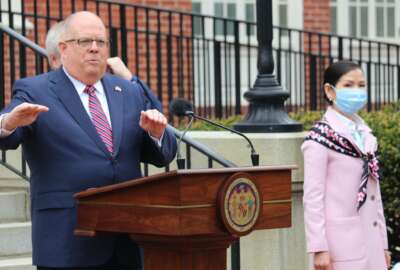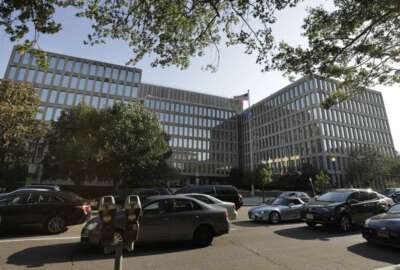Let’s talk about those reopening plans
Some agencies are preparing to provide masks for their employees when they return. Others aren't requiring them. At some organizations, telework will be...
If you’re expecting more top-level guidance from the Trump administration on reopening, it’s probably not happening.
In the early days of the pandemic, members of Congress had asked OMB and the Office of Personnel Management for more specific, clear directives for the federal workforce, citing inconsistencies in how agencies applied telework, leave and flexible work schedules for employees.
“We really believe agency heads need to have the discretion to be able to make many of these decisions because their workforces are so diversified and the number of localities that they work in is so diversified,” Russell Vought, acting director of the Office of Management and Budget, said last week before the Senate Homeland Security and Governmental Affairs Committee.
The committee met (remotely) to consider Vought’s nomination to become the permanent OMB director.
“We have tried to make sure they have a grid that follows the phases of the governors in which their offices are located and to ensure they don’t open up if they don’t have the necessary personal protective equipment or other resources to be able to keep their employees safe,” Vought said. “We want to make sure they have the flexibility to do that. One of the reasons we have not provided more of a directive across federal government is because this is a 50 state issue, that needs to be thought through in conjunction with the public health officials on the ground.”
What makes sense for the IRS, which has hundreds of field offices and call centers around the country, won’t necessarily work for say, the Education Department or the Department of Homeland Security as they look to “reopen” or resume “more normal” operations.
There are, of course, general commonalities in the reopening plans. Most agencies seem to be following the three-phase framework that the Trump administration detailed for agencies back in April, with a few employees returning during phase one, more in phase two and most in phase three.
The return dates, as you might expect, differ depending on the agency and its location.
But some are taking different approaches with their reopening policies, specifically in how they plan to provide masks and extend accommodations for their employees.
The Agriculture Department is planning to provide reusable masks for employees, who are expected to wear them throughout much of the work day. Visitors — the few who will be allowed into government buildings in the early days of reopening — are expected to bring their own face coverings.
Masks aren’t required at the Office of Personnel Management. According to its reopening plan, OPM will provide masks to security staff and others with public-facing jobs; everyone else can fend for themselves if they choose.
The Energy Department is taking still a different approach. At the department’s headquarters, employees are encouraged — especially in crowded hallways, elevators and entrances — to wear a mask, but they’re not required. Energy may provide masks at building entrances for visitors and others who want one one.
Most of the major federal employee unions, for the record, have called on agencies to provide face coverings and other protective equipment for their employees.
The language choices on telework and other accommodations also differ slightly.
OPM’s reopening plan describes an effort to “continue to encourage telework” during phases one and two. “Unrestricted staffing” will resume during phase three.
At Energy and Agriculture, it’s up to supervisors to determine who can and should return in the first and second phases. The focus, according to their reopening plans, seems to be on employees who can’t perform their duties at home or those who could handle their jobs with more ease at the office.
Telework will continue for most everyone else at both of those agencies, including employees at high risk for coronavirus or those with child or dependent care responsibilities.
At Energy, just 3.7% of a 7,000-person workforce in the national capital region will return to their facilities in phase one, which starts June 8. That means about 259 employees will make the trek into the office.
It’s still unclear how many USDA employees will return to their offices in the Washington, D.C. region, but the department anticipates the numbers will be limited to point that it can offer parking to most who want it during phases one and two.
The Interior Department has allowed supervisors to approve up to 20 hours of excused absence for employees who can’t telework and whose child care options have been impacted by the pandemic. This policy will continue until the associated schools resume in-person teaching, Interior has said. Interior reopening memos also encourage supervisors to mutually agree to flexible work schedules for employees, particularly those who can telework but need time during the day to care for their children.
Smaller agencies, perhaps, have an easier time issuing and extending mandatory telework orders for their employees. The Merit Systems Protection Board, which has field offices at various locations across the country, has mandatory telework in place through at least June 12.
What do you think of your agency’s reopening plan — if you’ve heard about it? If you’ve been teleworking this whole time, do you want to return, and when? And do you feel comfortable enough with your agency’s plan to come back?
Nearly Useless Factoid
By Alazar Moges
Adults have 206 bones in their body. But we are actually born with 300 bones that fuse together as we grow — ultimately ending up with 206.
Source: WebMD
Copyright © 2024 Federal News Network. All rights reserved. This website is not intended for users located within the European Economic Area.
Nicole Ogrysko is a reporter for Federal News Network focusing on the federal workforce and federal pay and benefits.
Follow @nogryskoWFED
Related Stories






